Hello! I’m Michael Zhang, a Chinese travel enthusiast passionate about history and culture. Over the years, I’ve explored museums, ancient sites, and cultural landmarks in more than 50 countries. In my view, the best way to truly understand a city is through its museums. This article will take you inside one of Beijing’s cultural treasures — the Capital Museum. Whether you’re a deep traveler drawn to history or a first-time visitor seeking cultural insight, this guide will provide you with practical tips and meaningful perspectives.
Summary
Capital Museum Introduction
The Capital Museum is a comprehensive institution dedicated to collection, exhibition, research, and education. It stands on par with Beijing’s National Museum of China. If you’re unable to secure a ticket to the National Museum, the Capital Museum offers a fantastic alternative. The museum spans 63,000 square meters, with 12,000 square meters of exhibition space. Its origins trace back to the Beijing Municipal Administration of Cultural Heritage established in 1953, and it officially opened to the public in 1982.
- Address: 16 Fuxingmen Outer Street, Xicheng District, Beijing (Apple Maps/Amap)
- Opening hours: 9:00 AM – 5:00 PM (last entry at 4:00 PM); closed on Mondays
- Suggested visit duration: 3–4 hours
- Best seasons to visit: All year round
- Ticket prices: Free admission with reservation required (including for seniors); special exhibitions require ticket purchase
- Current special exhibitions: View official website
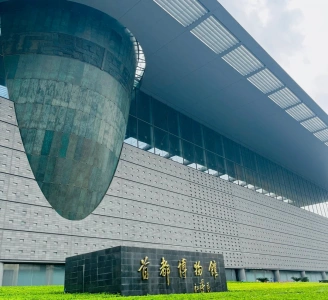
Capital Museum Map
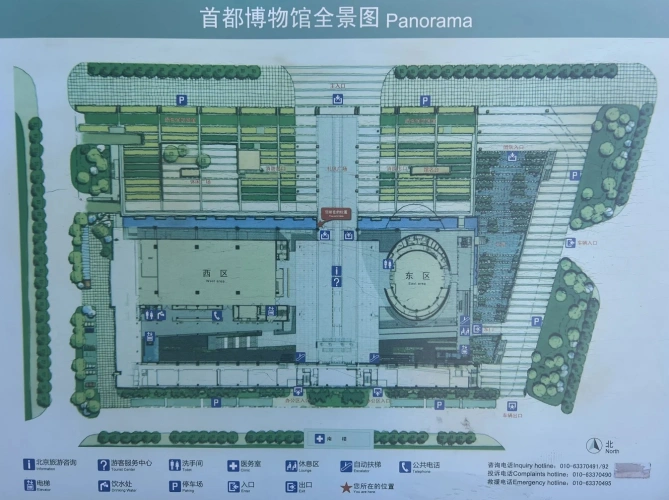
Why You Should Visit Capital Museum
Extensive Displays of Historical and Cultural Heritage
The museum houses a rich variety of cultural relics and artworks. Through immersive exhibitions and interactive elements, it tells the story of Beijing’s profound cultural roots. Exhibits range from recreated scenes of early Peking Man life to the imperial traditions and urban culture of the Ming and Qing dynasties, as well as the city’s transformation through key events like the 1911 Revolution and the May Fourth Movement.
Unique Architectural Style and Spatial Design
The architectural design of the Capital Museum blends tradition with modernity. Its grand exterior and clean geometric lines are infused with classic Chinese elements like dougong brackets and bronze motifs, creating a deeply cultural aesthetic. Inside, the high-ceilinged central hall and glass dome welcome natural sunlight, offering a serene and dignified atmosphere. With clear signage and thoughtful layout, visitors can easily navigate from one exhibition to another.
Diverse Exhibition Themes
In addition to its permanent exhibitions, the Capital Museum frequently hosts a variety of special and temporary exhibitions. The permanent collection traces Beijing’s evolution from prehistoric times to the present. Meanwhile, special exhibits delve into themes such as art, folklore, and history, including “Masterpieces of Ancient Chinese Porcelain” and “Beijing Stories: A Glimpse into Local Folk Culture.” Temporary exhibitions keep the experience fresh and aligned with contemporary topics.
Top Things to Do in Capital Museum
Must-See Artifacts
The Capital Museum’s extensive collection includes national treasures and iconic cultural relics. These highlighted pieces represent the height of artistic and technical achievement from different periods of Chinese history, and they are absolutely worth your time.
Boju Li (伯矩鬲, bó jǔ lì)
Dating from the early Western Zhou period, this bronze li tripod exemplifies the pinnacle of Chinese bronze craftsmanship. Each part of the vessel is decorated with vivid ox-head motifs, reflecting both the reverence for cattle and the era’s advanced casting techniques. Its grand form and intricate designs reveal the values and aesthetic principles of early Zhou ritual culture.
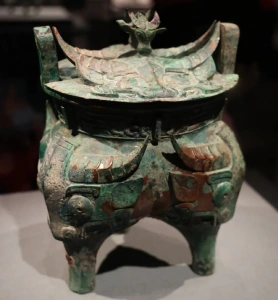
Western Zhou Ban Gui (西周班簋, bān guǐ)
This gui was a sacrificial vessel used by a noble named Ban during the Western Zhou dynasty. Inside the bronze vessel is an impressive 198-character inscription, chronicling Ban’s military expedition alongside Lord Mao. This text provides rare and valuable insights into the political and military dynamics of the time, making it a vital artifact for historical research.
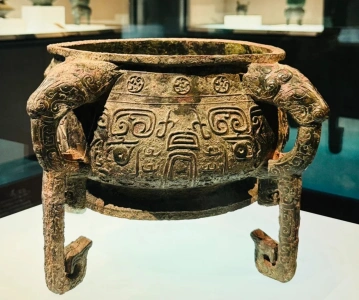
Guanyin Bodhisattva in Water-Moon Pose (水月观音菩萨像)
This sculpture, a masterpiece from the Yuan dynasty, showcases a harmonious blend of multiple artistic techniques, including carving, glazing, and porcelain molding. The serene Guanyin is seated on a rock in the classic water-moon pose, radiating calm and compassion. Her gentle facial features and flowing garments are hallmarks of Yuan porcelain artistry.
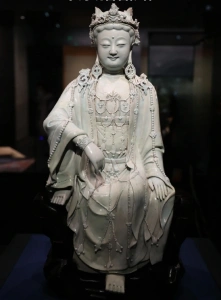
Emerald Thumb Ring (翠扳指)
Carved from an exceptionally rare variety of jadeite known as “ice jade,” this thumb ring glows with a soft green hue. Originally worn by elite men and members of the royal family during archery, the ring served both practical and symbolic purposes. Its extraordinary craftsmanship and rarity have earned it an estimated value of 200 million RMB, making it one of the museum’s most prized possessions.
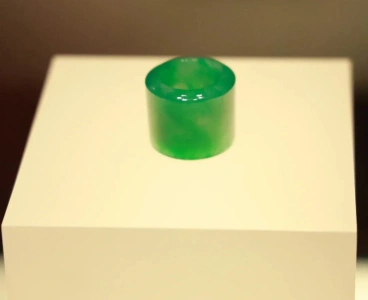
Jingde Street Archway (景德街牌楼)
As the first artifact officially accepted into the Capital Museum’s collection, this archway carries significant historical weight. Originally located on Beijing’s Jingde Street, it was dismantled and later reassembled inside the museum. With its precise structure and elaborate carvings, the archway represents the finest traditions of Beijing’s vernacular architecture.
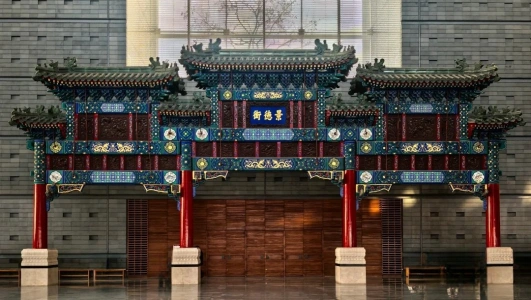
Capital Museum Ticket Guide
The Capital Museum does not require ticket purchases, but reservations are mandatory. Visitors can make a reservation up to seven days in advance. The only way to reserve is via the museum’s official WeChat public account.
Ticket Reservation Channel
- Online: Via official WeChat accounts
Capital Museum Audio Guide
The Capital Museum offers free audio guide devices for visitors to borrow.
- Supported Languages: Chinese, English
- Fee: Free to use, with a refundable deposit of 200 RMB. Visitors can bring their own wired earphones or purchase one for 15 RMB. If you don’t buy earphones, you can still hold the device to your ear and listen.
Recommended Route for Visiting the Capital Museum
The museum is divided into a Square Hall and a Round Hall. It is recommended to start with the Square Hall.
- Square Hall: Explore from lower to upper levels
- B1 to 1st Floor: Special exhibitions, often covering history, art, and folklore
- 2nd–3rd Floors: Beijing General History Exhibition, featuring signature artifacts and top highlights — take your time on these two floors
- 4th Floor: Old Beijing Theater Exhibition
- 5th Floor: Old Beijing Folk Life Exhibition
- Round Hall: Also recommended to move upward via the escalator on the east side, and descend by elevator
- 1st Floor: Multimedia introduction to Beijing
- 2nd Floor: Modern and contemporary Chinese painting exhibition
- 3rd Floor: Chinese calligraphy exhibition
- 4th Floor: Bronze ware exhibition
- 5th Floor: Jade artifacts exhibition
- 6th Floor: Pagoda relics exhibition
Recommended Food Options Near Capital Museum
There is a restaurant inside the museum. However, open flames are prohibited, so the menu is limited to coffee, cakes, and light meals. Since there are not many restaurants in the immediate area, it’s recommended to eat inside if you’re feeling hungry during your visit.
Capital Museum Restaurant
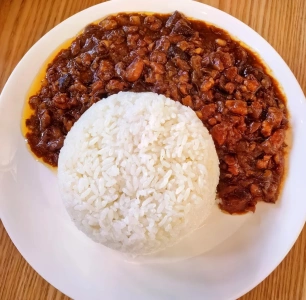
- Location: Round Hall B1 and Square Hall 2nd Floor
- Opening Hours: 9:00 AM – 5:00 PM
- Average Spend: 40 RMB per person
How to Get to Capital Museum from Downtown Beijing
The best way to reach the Capital Museum is by subway. Since the museum is located in central Beijing, traffic congestion makes taxis less ideal. For independent travelers, taking the subway is the most efficient choice, and it only takes 7–10 minutes on foot from the nearest station.
Subway
From central Beijing, take Metro Line 1 or Line 16 and get off at Muxidi Station. Exit from C1 (southeast) and walk to the Capital Museum in just 7–10 minutes.
- Transportation Card Purchase: Klook Deals, KKday Offers
Bus
Several bus lines stop near the museum. One convenient option is Bus Line 1, which stops at the Gonghui Dalu (工会大楼) station. From there, it’s only a 7–8 minute walk to the museum.
- Transportation Card Purchase: Klook Deals, KKday Offers
Taxi / Ride-Hailing
From downtown Beijing, a taxi or ride-hailing trip takes about 30 minutes and costs approximately 30 RMB.
FAQ
Yes. Visitors are welcome to bring strollers and wheelchairs. The museum’s main visiting routes have smooth surfaces, and most long staircases are equipped with ramps, making movement convenient for all.
The museum provides free luggage storage at the first-floor cloakroom. Suitcases and other personal items can be stored without charge.
Essential Beijing Travel Resources
- Comprehensive Beijing Travel Guide 📖
- Beijing Travel Recommendations 🏙️
- Hotel Recommendations 🏨
- Transportation Guides ✈️ 🚇 🚄 🚆
- Essential Travel Tips & Tools 🗺️ 🍜 📱 💸 🌤️ 💊

 English (US)
English (US)  English (Hong Kong)
English (Hong Kong)  English (Malaysia)
English (Malaysia)  English (Singapore)
English (Singapore)  繁體中文
繁體中文 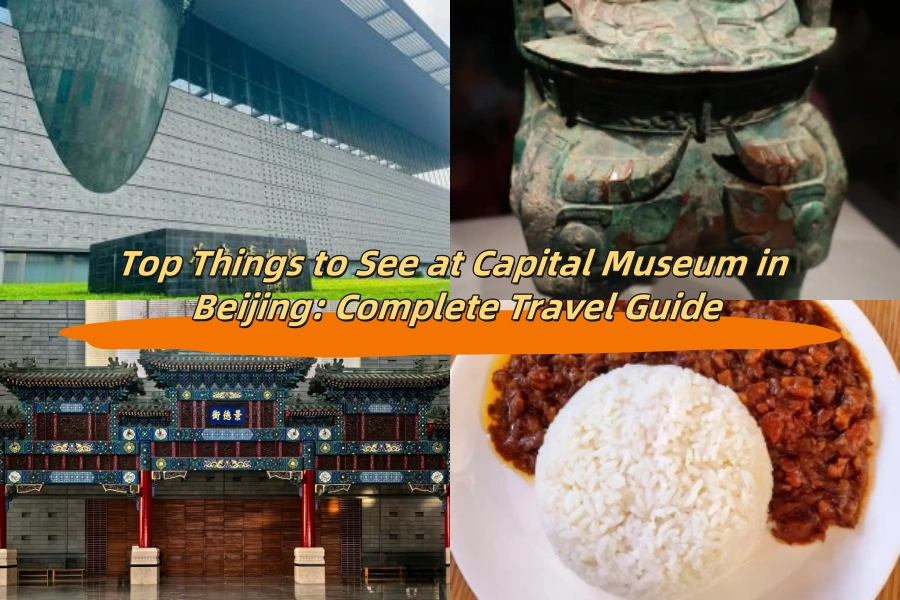
Comment (0)